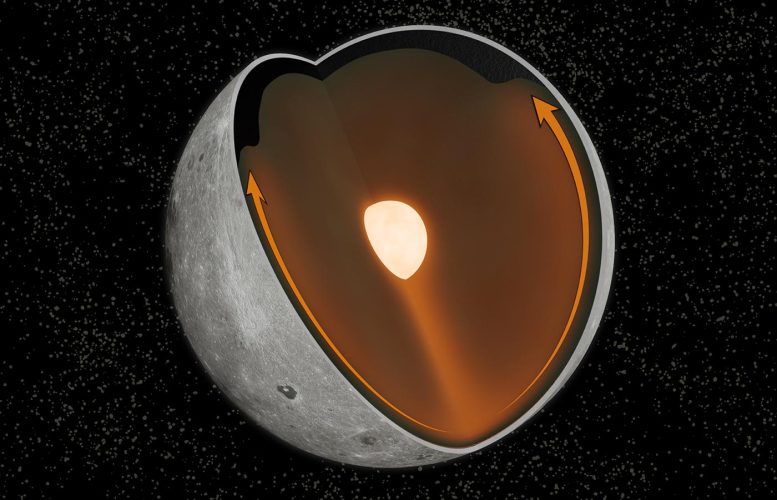
Μια νέα μελέτη αποκαλύπτει ότι μια αρχαία σύγκρουση στον νότιο πόλο της Σελήνης έχει αλλάξει τα μοτίβα μεταφοράς στο σεληνιακό μανδύα, εστιάζοντας σε μια ομάδα στοιχείων που παράγουν θερμότητα στην κοντινή πλευρά. Αυτά τα στοιχεία έπαιξαν ρόλο στο σχηματισμό του απέραντου σεληνιακού πετάλου ορατού από τη Γη. Πίστωση: Ματ Τζόουνς
Νέα έρευνα δείχνει πώς η πρόσκρουση από τη λεκάνη του Νότιου Πόλου της Σελήνης-Λεκάνη Aitken σχετίζεται με την έντονη αντίθεση στη σύνθεση και την εμφάνιση μεταξύ των δύο πλευρών της Σελήνης.
Το πρόσωπο που δείχνει η Σελήνη στη Γη φαίνεται πολύ διαφορετικό από αυτό που κρύβει στην μακρινή πλευρά της. Στην κοντινή πλευρά κυριαρχούν οι σεληνιακές Πέρσες – τα τεράστια, σκουρόχρωμα υπολείμματα αρχαίας λάβας. Από την άλλη πλευρά, η μακρινή πλευρά γεμάτη κρατήρα ουσιαστικά στερείται εκτεταμένων χαρακτηριστικών φοράδας. Ο λόγος για τη μεγάλη διαφορά μεταξύ των δύο πλευρών είναι ένα από τα πιο διαρκή μυστήρια του φεγγαριού.
Τώρα, οι ερευνητές έχουν μια νέα εξήγηση για το φεγγάρι με δύο όψεις – μια εξήγηση που σχετίζεται με μια γιγαντιαία πρόσκρουση πριν από δισεκατομμύρια χρόνια κοντά στον νότιο πόλο της Σελήνης.
Μια νέα μελέτη που δημοσιεύτηκε στο Science Advances δείχνει ότι η πρόσκρουση που σχημάτισε τη γιγάντια λεκάνη του Νότιου Πόλου-Aitken (SPA) του φεγγαριού θα είχε δημιουργήσει ένα τεράστιο νέφος θερμότητας που εξαπλώνεται στο εσωτερικό του φεγγαριού. Αυτό το λοφίο θα συγκρατούσε ορισμένα υλικά – έναν συνδυασμό σπάνιων γαιών και στοιχείων που παράγουν θερμότητα – καθώς και το κοντινό φεγγάρι. Αυτή η συγκέντρωση στοιχείων θα μπορούσε να έχει συμβάλει στην ηφαιστειακή δραστηριότητα που οδήγησε στη δημιουργία των κοντινών ηφαιστειακών πεδιάδων.

Εκτεταμένες ηφαιστειακές αποθέσεις κυριαρχούν στην κοντινή πλευρά της Σελήνης (αριστερά), ενώ η μακρινή πλευρά (δεξιά) περιέχει πολύ λιγότερα. Ο λόγος για τη μεγάλη διαφορά μεταξύ των δύο πλευρών είναι το μυστήριο του αιώνιου φεγγαριού. Πίστωση: Πανεπιστήμιο Brown
«Γνωρίζουμε ότι μεγάλες επιπτώσεις όπως αυτή που διαμόρφωσε το SPA θα δημιουργήσουν πολλή θερμότητα», δήλωσε ο Matt Jones, Ph.D. Υποψήφιος στο Πανεπιστήμιο Brown και κύριος συγγραφέας της μελέτης. Το ερώτημα είναι πώς αυτή η θερμοκρασία επηρεάζει την εσωτερική δυναμική της Σελήνης. Αυτό που δείχνουμε είναι ότι κάτω από οποιεσδήποτε λογικές συνθήκες τη στιγμή που σχηματίζεται το SPA, καταλήγει να συγκεντρώνει αυτά τα στοιχεία που παράγουν θερμότητα στην κοντινή πλευρά. Εικάζουμε ότι αυτό συνέβαλε στην τήξη του μανδύα που οδήγησε στις ροές λάβας που βλέπουμε στην επιφάνεια. “
Η μελέτη ήταν μια συνεργασία μεταξύ του Jones και του συμβούλου του, Alexander Evans, επίκουρου καθηγητή στο Πανεπιστήμιο Brown, μαζί με ερευνητές από το Πανεπιστήμιο Purdue, το Lunar and Planetary Science Laboratory στην Αριζόνα, το Πανεπιστήμιο Stanford και[{” attribute=””>NASA’s Jet Propulsion Laboratory.

A new study reveals that an ancient collision on the Moon’s south pole changed patterns of convection in the lunar mantle, concentrating a suite of heat-producing elements on the nearside. Those elements played a role in creating the vast lunar mare visible from Earth. Credit: Matt Jones
The differences between the near and far sides of the Moon were first revealed in the 1960s by the Soviet Luna missions and the U.S. Apollo program. While the differences in volcanic deposits are plain to see, future missions would reveal differences in the geochemical composition as well. The nearside is home to a compositional anomaly known as the Procellarum KREEP terrane (PKT) — a concentration of potassium (K), rare earth elements (REE), phosphorus (P), along with heat-producing elements like thorium. KREEP seems to be concentrated in and around Oceanus Procellarum, the largest of the nearside volcanic plains, but is sparse elsewhere on the Moon.
Some scientists have suspected a connection between the PKT and the nearside lava flows, but the question of why that suite of elements was concentrated on the nearside remained. This new study provides an explanation that is connected to the South Pole–Aitken basin, the second largest known impact crater in the solar system.
For the study, the researchers conducted computer simulations of how heat generated by a giant impact would alter patterns of convection in the Moon’s interior, and how that might redistribute KREEP material in the lunar mantle. KREEP is thought to represent the last part of the mantle to solidify after the Moon’s formation. As such, it likely formed the outermost layer of mantle, just beneath the lunar crust. Models of the lunar interior suggest that it should have been more or less evenly distributed beneath the surface. But this new model shows that the uniform distribution would be disrupted by the heat plume from the SPA impact.
According to the model, the KREEP material would have ridden the wave of heat emanating from the SPA impact zone like a surfer. As the heat plume spread beneath the Moon’s crust, that material was eventually delivered en masse to the nearside. The team ran simulations for a number of different impact scenarios, from dead-on hit to a glancing blow. While each produced differing heat patterns and mobilized KREEP to varying degrees, all created KREEP concentrations on the nearside, consistent with the PKT anomaly.
The researchers say the work provides a credible explanation for one of the Moon’s most enduring mysteries.
“How the PKT formed is arguably the most significant open question in lunar science,” Jones said. “And the South Pole–Aitken impact is one of the most significant events in lunar history. This work brings those two things together, and I think our results are really exciting.”
Refernece: “A South Pole–Aitken impact origin of the lunar compositional asymmetry” by Matt J. Jones, Alexander J. Evans, Brandon C. Johnson, Matthew B. Weller, Jeffrey C. Andrews-Hanna, Sonia M. Tikoo and James T. Kean, 8 April 2022, Science Advances.
DOI: 10.1126/sciadv.abm8475

“Ερασιτέχνης διοργανωτής. Εξαιρετικά ταπεινός web maven. Ειδικός κοινωνικών μέσων Wannabe. Δημιουργός. Thinker.”


